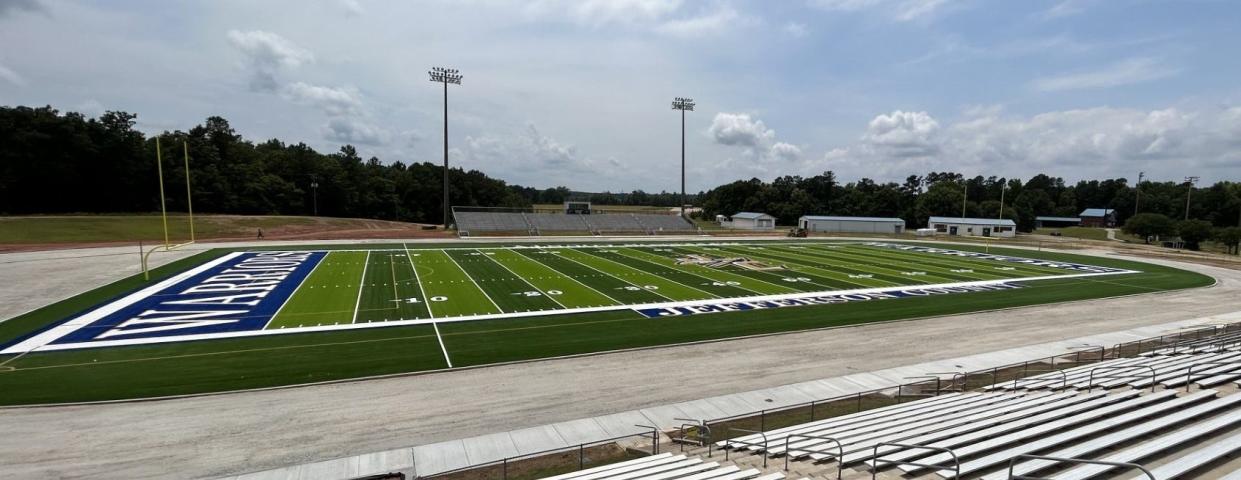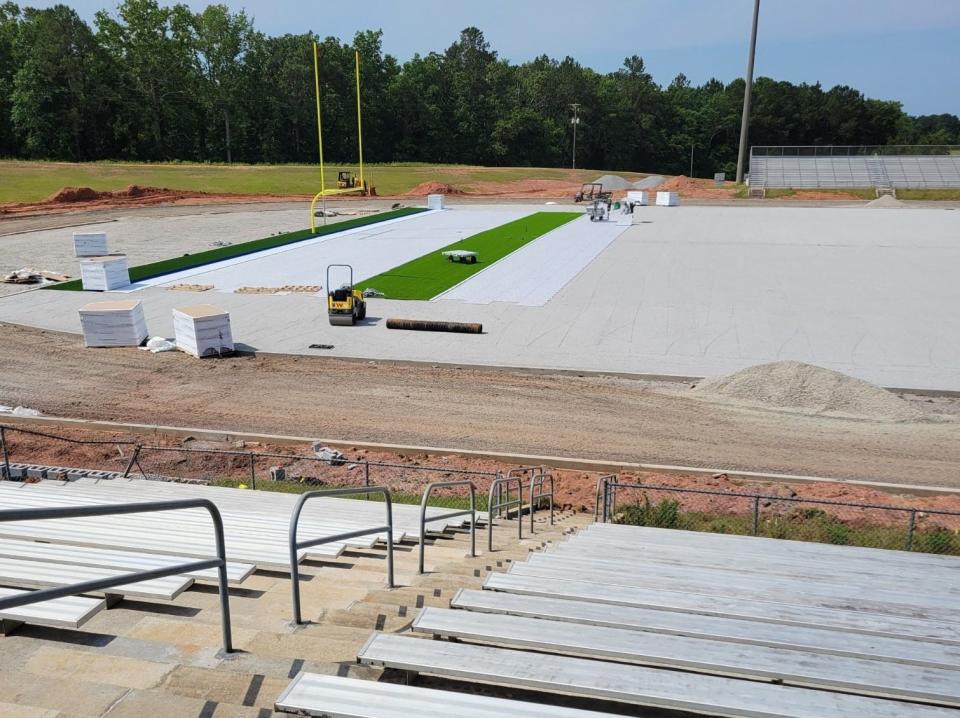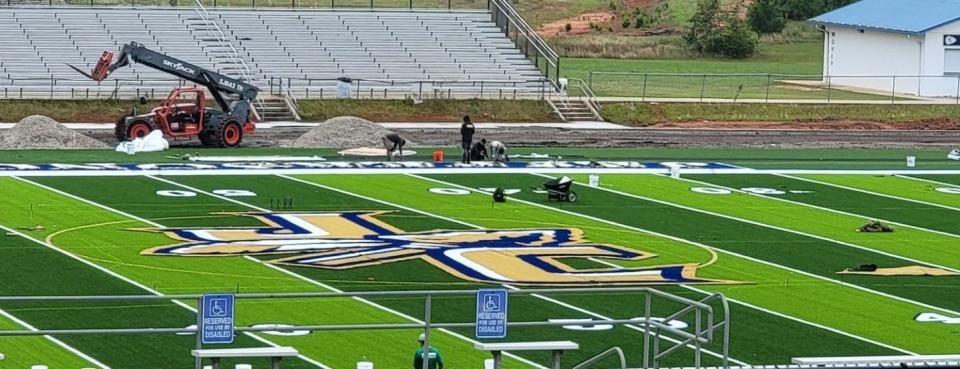Warrior Field makes switch to artificial turf

No more cutting or weeding or striping or watering or filling divots or killing ants or searching for broken sprinkler lines.
Not only are Jefferson County High School Warrior players and fans excited about their stadium’s switch to artificial turf, but the coaches and administration say the investment is expected to pay off for decades. The project was paid for with Education Special Local Option Sales Tax (SPLOST) funds.
“We are really excited about the field,” said Head Warrior Football Coach Marlo East. “Having a surface like this just really excites the kids.”
Sometimes, he said, it over excites them. He says he can’t count how many times players have asked him what type of special cleats they need to buy.
“If that brings them joy and excitement, I am all for it because they are the reason for all of it,” East said.
For the last three months contractors have been working to prepare and install the new artificial turf in Warrior Stadium and continue to work on replacing the surrounding track.
“We talked to the coaches about what we wanted to do and we started looking at the costs, not just initial costs but the long-term costs of sod versus artificial turf,” said Jefferson County School Superintendent Sam Dasher. “We found that the savings with the artificial turf over time far eclipses the cost of a sod field.”
A similar field, he said, would last colleges who play several more sports on it, 20 to 25 years. With the Warriors only playing football, soccer and flag football on theirs, they expect it to last longer. The field, which was recently completed, sports white lettering with gold highlights and a giant “JC” in the center. It is also permanently lined for both football and soccer.
“The maintenance is a big thing,” East said. “Not having to line it off before every game, that is an extra big thing. Most time coaches had to go out there and paint the lines on the field. Unless you have four or five guys out there with you, it takes two and a half to three hours to line one off the right way. And even then you were going to have some squiggly lines because nobody is perfect.”

Dasher added that sod fields also have to undergo significant rebuilds, costing as much as a quarter-million dollars every decade or so.
“A sod field would have to be redone at least three times in the time that this one will,” Dasher said. “This one will last until most of us are gone. If we change it, it will be because we want to change the colors. The field itself will not wear away.”
East said he played on artificial turf during his college years and is looking forward to his team taking to the new turf this fall.
“I love that playing surface,” East said. “I feel like it does help as far as injuries go. I always felt your feet move better and everything’s better on a field like that. The kids talk about it every day. They watched the whole process all the way through. They were letting me know the state of the field before I even walked down there.”
Dasher said that another primary concern when making the decision to change the field’s turf was the safety features that are designed into these fields. The surface and subsurface are designed to protect athletes from soft tissue injuries to ankles, knees and ligaments tears.
“It’s also designed to protect against concussions,” Dasher said. “There is a less likely chance that a child will suffer a concussion on this field than on sod or any other artificial turf. We did the research on the field to give our kids the best playing surface, to give the community something they could look at and be proud of but would also be cost-efficient over time.”
East said that he feels the science behind the design makes sense.
“When I was in college, I saw guys plant their foot on grass and sometimes that cleat would get stuck in the ground and that’s usually not good for the athlete,” East said.

Jefferson County is one of several area schools making the change.
“Warren County is actually putting in turf as we speak,” Dasher said. “They’ll be playing on it next year. Richmond County turfed Cross Creek, Butler, and rumor is Westside and Laney are supposed to be going over to turf this year. All of the Columbia County schools are switching to turf.”
Before the decision, Dasher said that he talked to school administrators, coaches and referees across the state.
“They say it’s faster. We asked about the injury situation and they say they haven’t seen any more injuries than they see with sod, and some said they see fewer,” Dasher said. “One of the referees said it does get hot in the summertime, but ours does not have the rubber chips that some have. Ours has something akin to a wood chip in it, which makes the field 10 to 15 degrees cooler than the others.”
The field is complete now, but construction crews continue to work on the surrounding eight-lane track which should be completed by Aug. 1. The former track has been cracking and crumbling for years due to erosion and subsurface washout from rain draining off of the home-side bleachers. Dasher said that the school has not been able to host a home track meet for at least 12 years.
The school system in going back with an Olympic track that will be rated so that the school can host regional and state track meets.
A drainage system has been installed to divert the draining water away from the track and field to the rear side of the visitors’ bleachers.
“It’s going to be nice to actually host some meets, host some relays and get people to come see what Jefferson County is like,” East said. “I think that’s a big thing for the community, to come out and see a different sport other than football. The track is supposed to be eight lanes and a gray surface. I’m really looking forward to seeing what it’s going to look like.”
In other school construction news, Dasher said the state board of education has approved the plan for construction at Carver Elementary School in Wadley.
“We got the approval of the plans and they are now in a bidding process,” Dasher said.
The school board is using COVID relief funds to build a new gym and front office suite and do extensive remodels of the classroom wings. The classrooms will be larger, the media center updated and the entire facility will get a new air filtration system. Both the media center and the dance studio will be larger than they currently are and a new security vestibule will be added at the front entrance.
Dasher said that he expects construction and renovation work to begin after July 4.
This article originally appeared on Augusta Chronicle: Warrior Field makes switch to artificial turf

